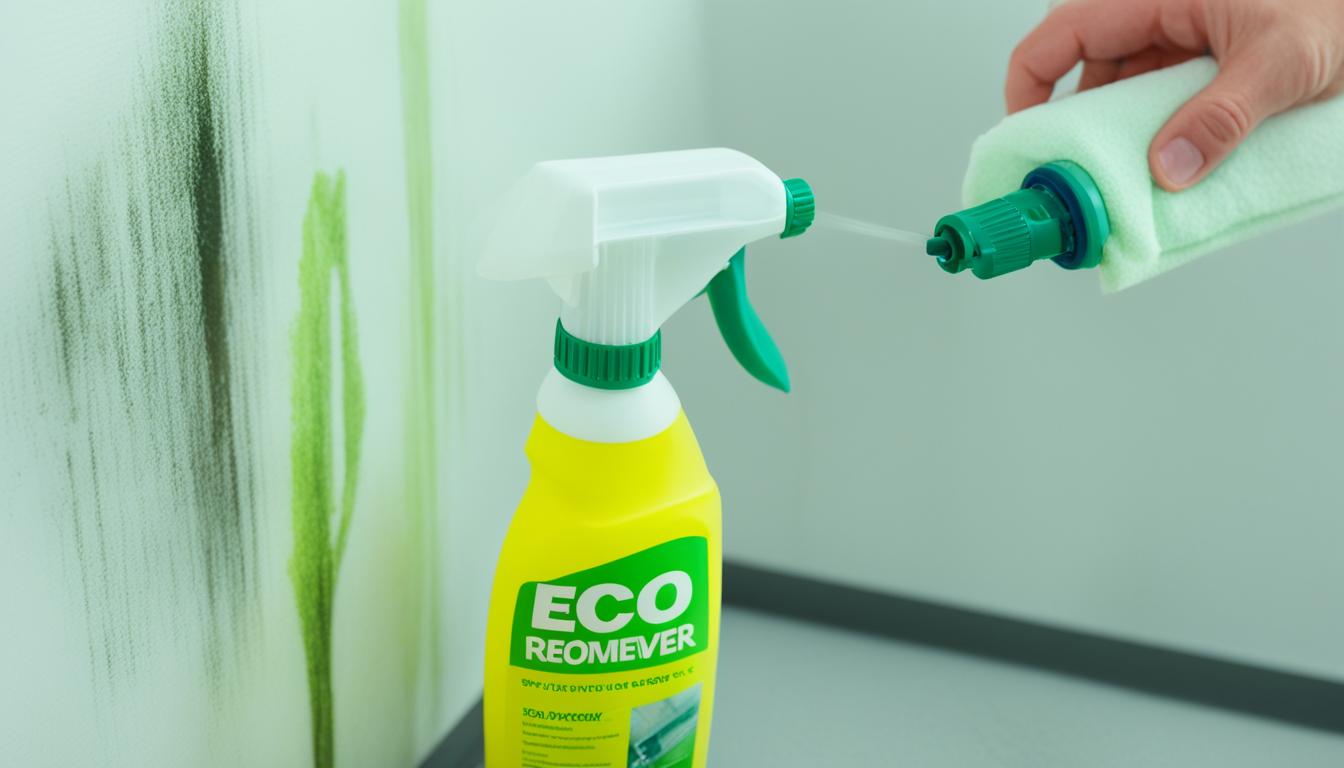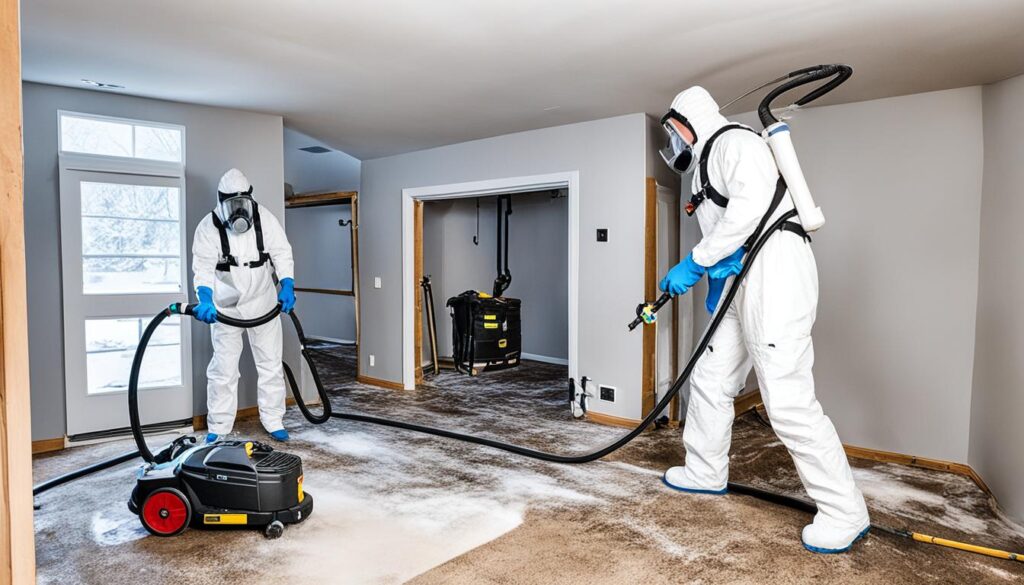
How-To: What Remove Mold Effectively & Safely
In this section, we will explore the best ways to eliminate mold and provide tips on choosing the right mold removal products. Mold can be a persistent problem in homes and can pose serious health risks if not addressed effectively. Whether you are dealing with a small patch of mold or a larger infestation, knowing the appropriate mold removal techniques and using effective mold removal products is crucial.
When it comes to mold removal, it’s important to understand that different techniques may be needed depending on the extent of the infestation and the type of surface affected. There are several methods available for removing mold, including scrubbing with a mixture of detergent and water, using specialized mold removal sprays, and employing advanced techniques such as dry ice blasting or ozone treatments. It’s essential to choose the most suitable method for your specific situation to achieve effective and safe mold removal.
Additionally, selecting the right mold removal products is vital for successful mold remediation. Look for products that are specifically designed for mold removal, as these will contain antimicrobial agents and ingredients that can kill mold spores and prevent regrowth. Always follow the instructions provided by the manufacturer and use the appropriate safety precautions, such as wearing protective equipment and ensuring proper ventilation.
Key Takeaways:
- Knowing the appropriate mold removal techniques is crucial for effective and safe mold remediation.
- Different methods may be needed depending on the extent of the mold infestation and the surface affected.
- Choosing the right mold removal products with antimicrobial agents is essential for preventing regrowth.
- Always follow the instructions provided by the manufacturer and wear protective equipment.
- Mold removal should be done promptly to prevent further damage and health risks.
Professional Mold Remediation Services for Effective Mold Removal
If you’re dealing with a mold infestation in your home, it’s crucial to address the issue promptly and effectively. While some homeowners may attempt to tackle mold removal on their own using DIY methods, the best way to ensure thorough and successful mold remediation is by hiring professional mold remediation services.
Mold can pose serious health risks and cause structural damage to your property if left untreated. Professional mold remediation services are equipped with the knowledge, experience, and specialized tools to identify the root cause of the mold problem and implement effective solutions.
One of the advantages of hiring professionals is their ability to accurately identify the signs of mold infestation. Some common signs of mold in your home include:
- Visible mold growth
- A musty odor
- Water stains or discoloration on walls or ceilings
- Peeling paint or wallpaper
- Increased humidity levels

By recognizing these signs early, professionals can determine the extent of the mold problem and develop a comprehensive plan for mold remediation.
“Professional mold remediation services offer a range of benefits, including:
- Thorough mold inspection and assessment
- Safe containment and removal of mold
- Proper disposal of contaminated materials
- Air quality testing and improvement
- Prevention of future mold growth
These services not only ensure effective mold removal but also help prevent the recurrence of mold infestations, providing you with peace of mind and a healthier living environment.”
However, if you’re dealing with a small-scale mold problem that doesn’t require professional intervention, there are some DIY mold removal methods you can try. Keep in mind that these methods are only suitable for minor mold issues and may not be as effective as professional remediation services.
DIY Mold Removal Methods:
- Wear protective gear, including gloves, goggles, and a mask, to avoid exposure to mold spores.
- Isolate the mold-infested area to prevent cross-contamination.
- Clean non-porous surfaces with a mixture of water and detergent or a vinegar solution.
- Scrub mold off porous surfaces using a brush and a mold-killing solution.
- Ensure proper ventilation and airflow to prevent mold growth.
- Monitor the affected area regularly for signs of mold regrowth.
Remember, if the mold problem persists or if you suspect extensive mold growth, it’s best to seek professional mold remediation services for a thorough assessment and effective removal.
How to Prevent Mold Growth and Future Infestations
Preventing mold growth and future infestations in your home is crucial for maintaining a healthy living environment. By following a few simple steps, you can significantly reduce the risk of mold becoming a problem in your home.
1. Control moisture levels: Mold thrives in damp and humid conditions. To prevent mold growth, it’s important to control moisture levels in your home. Keep humidity levels below 50% by using dehumidifiers or air conditioners, especially in areas prone to moisture accumulation like bathrooms and basements.
2. Proper ventilation: Adequate ventilation is essential for minimizing moisture buildup. Make sure your home is properly ventilated, especially in areas where moisture is common, such as kitchens and bathrooms. Use exhaust fans or open windows when cooking, showering, or doing laundry to allow fresh air to circulate.
3. Promptly address water leaks and spills: Any water leaks or spills should be addressed immediately to prevent mold growth. Regularly inspect your home for any signs of leaks, such as water stains, musty odors, or damp areas. If you find a leak, fix it promptly and thoroughly dry any affected areas.
4. Maintain proper insulation: Proper insulation can help prevent condensation and moisture buildup. Insulate your windows, walls, and pipes to reduce the chances of moisture seeping into your home. Additionally, ensure your home is properly sealed to prevent water intrusion through cracks and gaps.
By implementing these preventive measures, you can effectively reduce the risk of mold growth and future infestations in your home. Regular maintenance and vigilance are key in creating a mold-free environment for you and your family.




